Every day new technology is emerging in the manufacturing industry to help achieve the desired results. One such cutting process is diamond turning. This manufacturing process follows the same principles as typical turning processes where a workpiece is securely placed on a lathe and cut. However, this particular process uses a diamond-tipped cutting tool. Here’s a simple guide on what diamond turning entails.
What is turning?
This is a machining process utilized in manufacturing that enables you to cut or remove materials from an item using a stationary cutting tool, often on a lathe. The cutting tool, often a non-rotary tool bit, moves linearly as the item rotates. It can be done on the surface or internally, which in that case it will be referred to as boring.
There are various types of turning methods, including tapered turning, where cylindrical shapes are created gradually as the workpiece decreases from one end to another. Spherical turning creates spherical shapes, while hard turning is used on material with a hardness greater than 45 and often requires heat treatment.
Why use diamond?
Diamond is the toughest element and it is this ability to resist scratching and breaking that makes it ideal for use as a tool bit. In place of steel, titanium, and other metals, diamond is used to achieve high precision cutting.
Many diamond turning operations make use of a single-point cutting tool. This means that the cutting tool only has a singular fixed point and are referred to as single-point diamond turning (SPDT). However, even though diamond turning has become synonymous with SPDT, there are operations that use multiple-point cutting tools. In this case, the tool might have a contoured bit head to achieve the desired results.
What materials can be diamond turned?
Diamond turning is ideal when cutting materials that are meant to be used in infrared optics and certain non-linear optical components. A great example is potassium dihydrogen phosphate which is favored for its ideal optical modulating properties; since it is impossible to make optical components from this material using traditional methods.
Other materials include:
- Plastics such as nylon, acetal, acrylic, polypropylene, polycarbonate, and polystyrene.
- Metals include brass, aluminum, and its alloys, copper, nickel-phosphorus alloy, deposited via electrolytic or electroless nickel plating on other materials, gold, silver, zinc, and tin.
- Infrared crystals such as potassium dihydrogen phosphate (KDP), cadmium sulfide, cesium iodide, cadmium telluride, potassium bromide, zinc selenide, calcium fluoride, silicon, zinc sulfide, and more.
However, ferrous materials and titanium are not machinable this way as the carbon in the diamond, for instance can react with ferrous materials damaging the tool bit. Whether they are manufactured from natural or synthetic diamond, avoiding damage is key because of how expensive these tool bits are.
There are many advantages of diamond turning. They include speedy delivery as your workpieces are cut a lot faster. It also reduces tooling costs as the tool bit is quite durable. The process is also very accurate, allowing for the creation of new designs on sophisticated materials.













